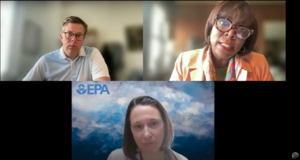Research and Webinar: How Countries Can Develop National Strategies for Food Loss and Waste
Scaling food recovery and donation is essential for human health as well as planetary health
Ertharin CousinNearly a decade ago, the international community agreed to cut food waste in half by 2030, as the human, climate, and resource costs of waste were too high to condone.
But progress has been slow as countries have struggled to implement food loss and waste strategies, a challenge that involves coordinating multiple government agencies and countless actors in the private sector and civil society, as well as a sophisticated communication strategy to bring the general public on board.
Through the Global Food Donation Policy Atlas, a collaboration of The Global FoodBanking Network (GFN) and Harvard Law School’s Food Law and Policy Clinic (FLPC), we’ve studied food donation and food loss and waste policies in dozens of countries, and our latest issue brief leans on that experience to deliver the best practices for developing national strategies.
Our recommendations include:
- setting clear goals for waste reduction, including a subgoal for how much food goes to donation for hunger relief
- explaining how countries must put a single agency or taskforce in charge of implementing this complex plan
- aligning stakeholders on the state and local level
- creating voluntary agreements to generate more buy-in and change from the private sector
To advance national strategies, GFN and FLPC, in partnership with Food for the Future, convened a panel of leading experts on April 23.
The event was kicked off by Emily Broad Leib, clinical professor of law and faculty director of FLPC.
“We launched the Atlas project to better understand these [food donation] laws and policies and share best practices,” said Broad Leib. “The goal today is to understand concerns, challenges, and ideas regarding national strategies for implementation of national food waste strategies.”

Pete Pearson, World Wildlife Fund USA; Ertharin Cousin, Food for the Future; Lana Coppolino Suarez, Environmental Protection Agency (US)
The discussion was moderated by Ertharin Cousin, founder and CEO of Food for the Future and former executive director of the World Food Program, who began by explaining the stakes.
“Scaling food recovery and donation is essential for human health as well as planetary health,” she said. “When I was at the World Food Program, my team calculated that if we could capture all the food loss on the continent of Africa, it would exceed the amount of food assistance across the continent. Imagine the difference such a change would make in the number of those hungry and malnourished.”
The panel discussion began with the United States, where “millions of tons of valuable resources are being thrown away” according to Lana Coppolino Suárez, associate manager in the materials management branch of the Environmental Protection Agency (EPA). “We can do better.”
But developing a national strategy around food waste has been years in the making and requires patience, said Suárez.
“It is going to take longer than you think” to design a national strategy, she advised. “The interagency coordination [between the EPA, the U.S. Department of Agriculture, and the Food and Drug Administration] took a lot of time.”
But as the paper outlines, involving many governmental agencies in the strategy is necessary. In Brazil, for example, the food waste strategy involves 20 government agencies for loss and waste to be addressed from farm to table.
Cousin next welcomed Pete Pearson, senior director of food loss and waste at the World Wildlife Fund USA, to the discussion. He has worked on strategies in many of the countries where WWF operates and says he always tries to spread a key message.
“You have to treat food differently,” he said, when advising others how to think about and communicate their food waste strategies. “It is not trash. Food is always food for something. It is food for people or food for animals or food for our soils. It needs to be separated and treated differently.”
Discussing strategies around the world is important, said Pearson.
“This harmonization around getting countries to adopt food donation strategies that are similar is amazing and the [Global Food Donation Policy] Atlas helps us re-envision what this could look like,” he said. “When we go across borders, there is continuity around things like food donation, food handling.
“It is totally within our capability to make this happen quickly, we don’t have to wait decades,” he added.
Finally, in a pre-recorded message, Valentina Huepe Follert from the circular economy office at the Chilean government’s ministry of the environment said the country has made strides.
“The National Organic Waste Strategy has been very well received from different sectors, including from the general public,” she said. “There is consensus that we need to advance on these issues, and public and private projects have advanced in organic waste utilization, but we know it is not enough.”
The next steps are to transform the national strategy — which aims to increase Chile’s utilization of organic waste from 1 percent to 66 percent by 2040 — into laws that codify food waste actions across the supply chain.
You can watch the full discussion moderated by Ertharin Cousin here.